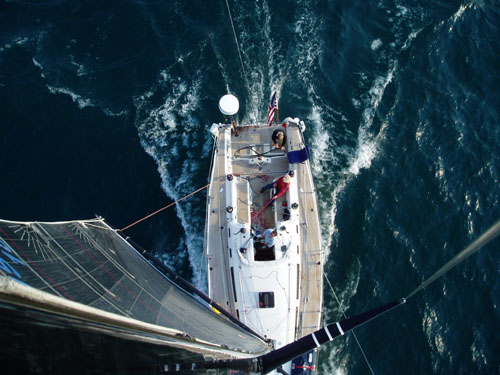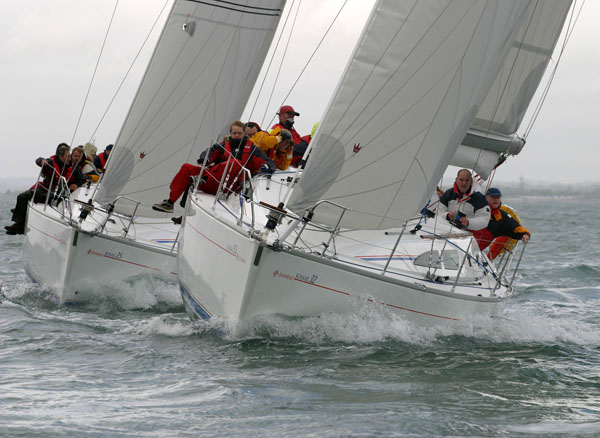|
|
| Image by kind permission of lustfish |
Good photographs of sailing are almost always captured from a boat - either the one in the photograph or another nearby craft. The first task for a photographer is consequently to arrange for a suitable boat and skipper to transport him or her to suitable locations. It is important to understand the hazards involved and make sure that all aspects of safety are considered. The most obvious of these are of course the weather and the state of the water on which the subject boats are sailing. Competitive races often take place on the open sea, so weather forecasts, local advice, a good skipper, life-jackets and a suitable boat are all important. Other considerations include the presence of salt water spray which has the potential to ruin expensive equipment. Be prepared with a suitable waterproof cover for camera and lens.
The best photographic opportunities occur when the photographer is reasonably close to the yachts or dinghies concerned. There are various ways to achieve a suitably close approach but care must always be taken not to interfere with craft that are racing. Races are highly competitive and having to avoid a photographer's boat may cost a competitor a couple of places. However, a knowledgeable skipper who understands what a race involves will also know where it is acceptable and safe to position a photographer's craft.
Sailing is not easy to follow for people who have never been involved in the sport. Boats may be in widely separated parts of the course yet closely positioned in the race to the finishing line. However, the marks that define the course are obvious places where all the boats in a race may be photographed in a predictable manner. The start and finish lines are also possibilities, but each has its own advantages and disadvantages.
 |
| Image by kind permission of Kuba Zwolinski / Snowdog |
A camera with a reasonably long telephoto zoom lens is an obvious choice for this type of photography. Plenty of light is available on open water, so it is possible in most instances to work with reasonably high shutter speeds and adequate depth of field. Always remember that the camera is moving up and down on the waves with the boat, so the shutter speed should always be above 1/250 sec. In many cases a faster shutter speed may be desirable - perhaps up to 1/2,000 or 1/3,000 sec. Open up the aperture as necessary, and don't be afraid to increase the ISO setting to accommodate fast shutter speeds. Blurred pictures are rarely of any use. Image-stabilized lenses and even gyro systems help in this respect, at least for photographers who are really serious about getting sharp images. Also, be aware of reflections from the surface of the waves and from the boats themselves. A polarizing filter may be used to eliminate at least some of the reflection problems.
Keeping the horizon reasonably level is important but can be quite difficult in a rolling and pitching boat. Train the eye to observe the horizon as well as focusing on the subject. Images can be straightened to some extent at a later stage, but where the subject is closely cropped the degree of adjustment may be limited.
In windy conditions all sorts of events and mishaps can be captured to make interesting images. Small boats capsize, larger boats get overpowered by strong winds and may get flattened, sails shred and get out of control, and crew members fall overboard and even climb masts to make repairs. Around marks, where boats are making a significant change in their direction of travel, sails are changed and competitors may find themselves in close proximity to other boats. All this activity produces good opportunities for photography.
Tightly-framed close-ups can also make excellent action shots. Capture the physical effort exerted by the crew as they handle sails and hang over the side of their boats, and zoom in close on the boat slicing through waves and throwing spray in to the air. If the images don't seem sufficiently exciting, zoom in or go closer - but don't get in the way of the race. In some cases, it may be possible to fit a waterproof camera to a suitable part of a boat, even the top of the mast, and use a wide-angle lens to capture the activity and excitement of the on-board racing environment.







